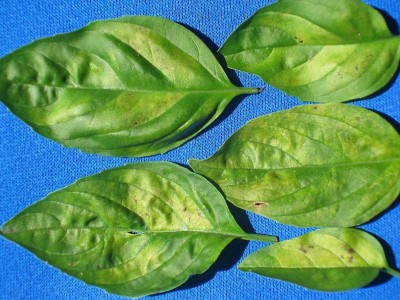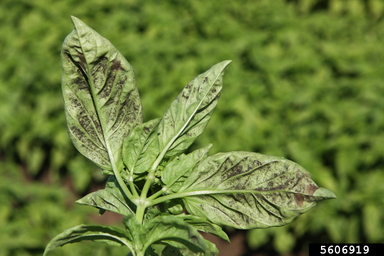Baisl Downy Mildew
Updated by: Nicole Davidow, Outreach Assistant
Reviewed by: Shuresh Ghimire, Ph.D.
Associate Extension Educator
Extension Vegetable Specialist
Updated: May 2025
Introduction
Basil downy mildew (BDM) was first confirmed in the United States of America in 2007. Having first been detected in Florida, by the following year, it was identified throughout the Northeast. BDM has been diagnosed in our region every year since. The pathogen does not overwinter in the Northeast, however. It is seed-borne and most commonly spreads by wind-borne spores (sporangia) that move north during the summer. Infections render the basil unsuitable for fresh market sale. Basil downy mildew can be found in commercially grown fields of basil as well as home gardens.


Symptoms
Symptoms of basil downy mildew are often confused with a nutrient deficiency because of the initial yellowing phase. Upon closer examination, you can determine downy mildew is the cause of the chlorosis (yellowing) if the color change is restricted by the veins on the upper surface of the leaf. In some areas of the leaf, you will find the yellowing of the leaf is followed by death of the leaf tissue.
Fuzzy purple-gray spores develop on the lower surface of yellowing leaves. Sometimes the sporulation on the undersides of the leaves will be pale, and other times it will be dark, looking as if soil has splashed up onto the leaves. Sporulation can also occur on the upper surface of the leaves in severe cases.
Spores spread through wind and splashing water. In prime, wet conditions, spores can germinate within two hours and infect plant tissue within four hours. If conditions are less favorable, five to 10 days can go by between infection and appearance of symptoms.
Necessary Conditions
As an obligate parasite, basil downy mildew needs a living host to survive and reproduce. It also cannot survive the cold temperatures of winter in the Northeast. Instead, oospores annually blow to our region from the South, where basil production is ongoing. While the pathogen for basil downy mildew has been found in basil seed, it is far more likely to spread through air-borne spores.
Finding basil varieties with resistance to basil downy mildew has been a significant point of research for over a decade. In 2009, researchers at Rutgers University and Cornell University (Wyenandt et al.) determined through resistance evaluation trials that sweet basil varieties (Ocimum basilicum) were generally more susceptible than other spice and ornamental basils such as O. citriodorum and O. americanum. Since then, breeders have been working on new varieties of basil that have a desirable flavor, storability, and yield while increasing the plant’s resistance to basil downy mildew. Breeding programs have made great progress. Learn about the Plant Resistance Evaluations from Cornell University.
Management
Cultural Practices
-
Promote good air circulation by using generous plant spacing and orienting crop rows parallel to the direction of prevailing winds.
-
Avoid overhead irrigation or water early in the morning to promote leaf dryness.
-
Plant in full sun.
-
Reduce humidity in greenhouses by using fans, lights, or raising the temperature.
-
Use clean seed. Do not use seed from infected plants.
-
Grow less susceptible varieties. Sweet basil varieties that had less severe downy mildew in trials include Amazel, Prospera Active, and Rutgers DMR cultivars such as Devotion, Obsession, Passion, and Thunderstruck.
Biological and Chemical Controls
Several biocontrol and biorational products are labeled for basil and/or downy mildew. In field studies conducted by Cornell University since 2010, results from fungicide evaluations have been variable by season or location. Oxathiapiprolin (Segovis), cyazofamid (Ranman 400SC), potassium salts of phosphorous acid (Fosphite), copper octanoate (Cueva) are labeled among others. For specific product information, visit the New England Vegetable Management Guide for disease control against basil downy mildew.
To control downy mildew e\ectively with fungicides, it is considered necessary to start before first symptoms and to make applications frequently. During the past few years, downy mildew has been confirmed in Connecticut in the field by the end of July and in the greenhouse as early as May.
To decide when to start fungicide applications or to plan early harvests to avoid downy mildew losses, growers should sign up for alerts via the Basil Ag Pest Monitor, monitor the basil downy mildew map, and regularly scout their basil crops for symptoms. The cucurbit downy mildew forecasting website may also be helpful as both pathogens likely share similar requirements for long-distance wind dispersal (e.g. overcast skies) and infection (e.g. wet leaves or high humidity).
References
McGrath, M. T. 2022. Basil Downy Mildew: Resistant Variety, Biopesticide, and Fungicide Evaluations. https://blogs.cornell.edu/livegpath/research/basil-downy-mildew/. Accessed May 23, 2025.
Wyenandt, C. A., J. E. Simon, M. T. McGrath, and D.L. Ward. 2010. Susceptibility of Basil Cultivars and Breeding Lines to Downy Mildew (Peronospora belbahrii). HortScience. 45(9): 1416-1419.
Consult and follow pesticide labels for registered uses. To avoid potential phytotoxicity problems, spot test before widespread use.
No discrimination is intended for any products not listed.
The information in this document is for educational purposes only. The recommendations contained are based on the best available knowledge at the time of publication. Any reference to commercial products, trade or brand names is for information only, and no endorsement or approval is intended. UConn Extension does not guarantee or warrant the standard of any product referenced or imply approval of the product to the exclusion of others which also may be available. The University of Connecticut, UConn Extension, College of Agriculture, Health and Natural Resources is an equal opportunity program provider and employer.